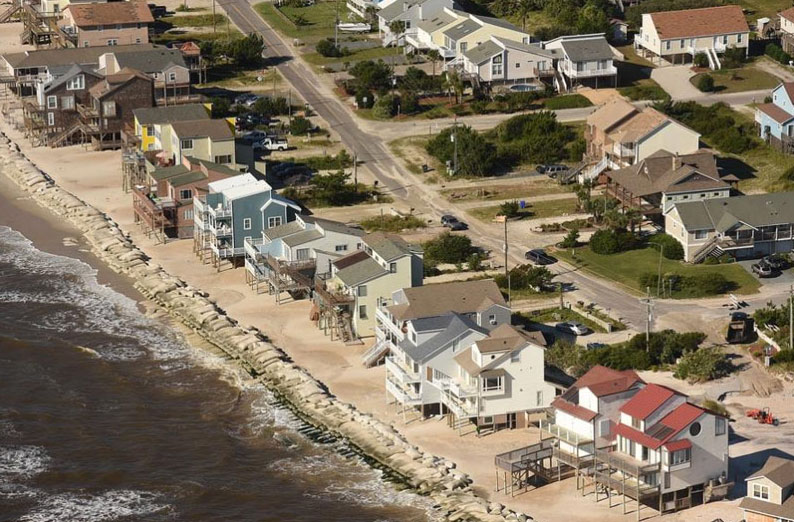
“A continuous sandbag wall on North Topsail Beach, N.C. shows the shore-hardening effect of such structures on beach loss, either by initial placement or by causing beach narrowing and loss. The photo was taken in October 2016 after Hurricane Matthew passed through the area. Note that the row of buildings is sitting on the beach and will suffer the same fate as other houses that have been lost in storms there (e.g., Hurricane Fran)”. —© William Neal, Orrin Pilkey & Norma Longo.
Photo courtesy of: Ken Blevins/Wilmington StarNews.
Excerpts;
Along parts of the East Coast, the entire system of insuring coastal property is beginning to break down…
Read Full Article, The New York Times (04-18-2017)
Developers don’t get it: climate change means we need to retreat from the coast, Guardian UK (15-03-2016)
It is preposterous to build in areas that are bound to flood. So why are real estate companies still doing it?..
Rising seas put brakes on developers’ march toward the ocean, SC; The State (06-01-2016)
Miami Beach Sees Rising Seas as No Threat to Real Estate Boom, For Now; Phys.Org (04-22-2015)
Californians Fight Over Whether Coast Should Be Rugged or Refined, The New York Times (02-09-2016)
Reuters’ Water’s Edge Report Part I & Part II (09-19-2014)
Despite laws intended to curb development where rising seas pose the greatest threat, Reuters finds that government is happy to help the nation indulge in its passion for beachfront living…
Sandy Reminds Us of Coastal Hazards, by Pr. Robert Young
“The Beaches Are Moving,” A Video featuring Orrin Pilkey, PhD
World famous coastal geologist Orrin H. Pilkey takes us to the beach and explains why erosion has become a problem…
Rethinking Living Shorelines, By Orrin H. Pilkey, Rob Young, Norma Longo, and Andy Coburn;Program for the Study of Developed Shorelines / Western Carolina University, March 1, 2012, Nicholas School of the Environment, Duke University
In response to the detrimental environmental impacts caused by traditional erosion control structures, environmental groups, state and federal resource management agencies, now advocate an approach known as “Living Shorelines”that embraces the use of natural habitat elements such as indigenous vegetation, to stabilize and protect eroding shorelines.
“Retreat from a Rising Sea: Hard Choices in an Age of Climate Change,” A book by Orrin H. Pilkey, Linda Pilkey-Jarvis, and Keith C. Pilkey
“Retreat from a Rising Sea: Hard Choices in an Age of Climate Change” is a big-picture, policy-oriented book that explains in gripping terms, what rising oceans will do to coastal cities and the drastic actions we must take now to remove vulnerable populations.









